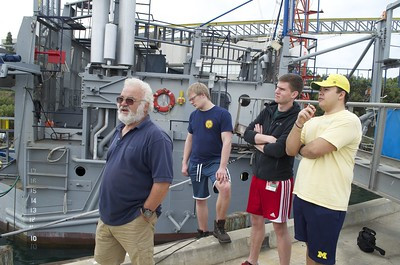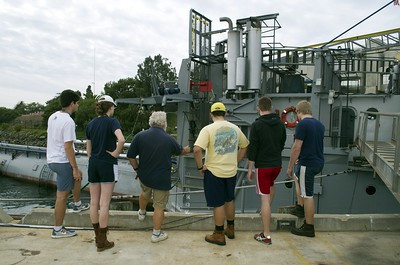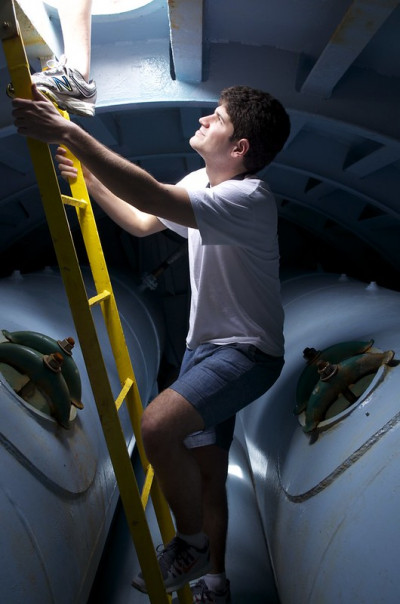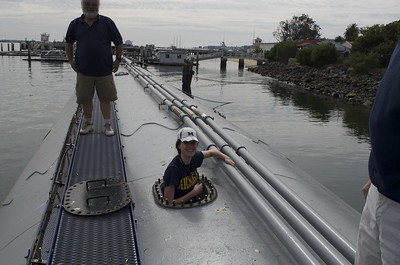When a group of students from the University of Michigan decided to design a new version of the novel Scripps research invention FLIP for their senior engineering project, they never dreamed that they would actually get to spend time aboard this nautical marvel. They were in for a big surprise.
R/P FLIP (Floating Instrument Platform) is a world-renowned research platform that is owned by the Office of Naval Research (ONR) and operated by the Marine Physical Laboratory at Scripps Institution of Oceanography, UC San Diego. Designed by Scripps researchers Fred Fisher and Fred Speiss, FLIP was intended to support only a single Navy program, but the platform capable of flipping 90 degrees in the ocean has supported hundreds of research operations since its 1962 launch. FLIP’s unorthodox design gives it superb stability, allowing researchers to collect important information on ocean acoustics, marine mammal studies, geophysics, meteorology, physical oceanography, and more. Given its unique ability to operate in both horizontal and vertical positions, FLIP is truly one-of-a-kind, and has captivated ocean scientists and the public for more than 50 years.
Vittorio Bichucher, one of the students now working on the FLIP redesign, originally became fascinated with the floating platform while completing a summer internship at the Glosten Associates, the Seattle-based naval architecture firm that was involved in FLIP’s construction. Glosten has continually supported FLIP and other Scripps ships over the years, and Vittorio’s internship gave him first-hand experience working on a remodeling and stability analysis project.

Bichucher was so inspired by FLIP that he began thinking about how he could incorporate aspects of its innovative design into his senior project. “I knew that’s what I wanted to do for my research, for my senior design, because it was just something so unique,” said Bichucher.
After sharing his project ideas with some fellow naval architecture and marine engineering students in his senior design class, Bichucher assembled the official FLIP II team, composed of himself, Phillip Cenzer, Jonathan Holbert, Harleigh Seyffert, and Michael Sypniewski.
All group members were equally drawn to the unique challenges that a FLIP redesign would present.
“I had wanted to try to do a submarine, or something like that, just for the added complexity and it’s something that most people don’t do, but FLIP presented us with that complexity and that uniqueness, and as far as uniqueness goes, there’s lots of subs, but there’s only one FLIP,” said Sypniewski.
The FLIP II team, who jokingly refer to themselves as a “motley crew,” decided that before starting the design process, they needed to gather and analyze all available information on the original model. Bichucher took the lead and contacted Captain William Gaines, assistant director of the Marine Physical Laboratory and FLIP program manager at Scripps. Although Bichucher and the team were simply hoping to ask Captain Gaines a few questions and obtain some specifications on FLIP, a fruitful dialogue and correspondence began to flourish.
“It was my impression from our email communication and the conference call, that this was a special student group, very dedicated, bright, and very interested in the FLIP project,” said Gaines, clearly impressed with the passionate FLIP II team.
During the 21 years Gaines has been associated with FLIP, he has received his fair share of requests and inquiries related to the platform, but they’ve mostly come from commercial companies working in the offshore oil and at-sea wind farm industry. The FLIP II team was the first student group to approach Gaines with a redesign project, and he was happy to support them in any way possible.

It soon became apparent that without the students actually seeing FLIP, it would be hard for them to fully grasp its design. “I suggested that it would be beneficial if a couple of the members of the group could travel to San Diego to view and photograph FLIP for the remainder of the group,” said Gaines.
The group was thrilled to hear about this generous offer, but knew that travel funds were tight. With determination and fervor, the FLIP II students wrote and submitted a proposal to cover flight costs for all five team members. The group’s hard work paid off as Steve Ceccio, chairman of the University of Michigan Naval Architecture and Marine Engineering Department, and David J. Singer, assistant professor of the Naval Architecture and Marine Engineering Department, kindly offered to split the cost of the students’ plane tickets.
Captain Gaines further helped the students cut travel costs by proposing that they live onboard FLIP for their weekend in San Diego. They couldn’t have asked for better accommodations.
Leaving behind the freezing winter temperatures of Michigan, the students embarked upon their journey to sunny San Diego. To say they were giddy with excitement would be an understatement.
“It’s incredible that they let us come,” said Seyffert during the group’s visit in late February. “I don’t think anyone has ever done this before for a project like this. I think for us it has been really, really edifying.”

Upon arrival, Tom Golfinos, officer in charge of FLIP, gave the students a full tour of the floating platform. They were able to survey and explore nearly every aspect of the research platform, from the tip of the hull to the end of the 355-foot long spar buoy. The students even had the opportunity to climb inside FLIP’s ballast tanks, which allowed them to observe the detailed interior design.
“This visit is exactly what we needed to move forward and to produce a successful design and we’re learning more than we ever thought,” said Holbert, who also noted the challenges of designing a dual-purpose configuration.
“Being able to have two arrangements, you have to design the vessel twice, so you have to design it in its horizontal position as well as vertical,” Holbert explained. “That’s something that’s very difficult to see from a two-dimensional drawing.”
The group’s first night spent upon the floating platform was quite an unforgettable experience—a scientific adventure with hints of a good old-fashioned slumber party.
“It took quite a while to fall asleep because you’re laying in your bunk and you’re hearing the noises of the ship and the mooring lines and everything, but then you’re also just thinking about where you are and how unique an experience this is, and you just want to jump out of your bunk and go explore every inch,” said Holbert.
The tight sleeping arrangements led to some interesting observations. “It’s concluded that Mike snores louder than the ship,” joked Bichucher.
“Well, I got a pillow in the face a few times,” added Sypniewski.
While the four men were crammed into one bunking room, Seyffert, the only woman aboard FLIP, had another bunking area entirely to herself. Although she appreciated having the extra space, Seyffert noted that being alone in the darkness was a bit creepy. “It’s scary, I don’t even know if the light turns on!” Seyffert said of her windowless room.
All kidding aside, the group used their weekend aboard FLIP to find out what changes could be implemented in the new design to improve functionality. The group wants to make FLIP II a self-propelled vessel, which is very different from the original design, which has no propulsion power and must be towed to sea by a tugboat.
“The idea of making the vessel completely independent, as to where it can go out on station and moor itself and be completely independent of the assistance of tugs—that would be a big change,” explained Holbert.
They also plan to increase the size of the vessel in order to improve habitability onboard FLIP II. “By going on a tour here, you know that space is really constrained, so we want to make sure that we don’t have too much room, but we want to be right at the exact spot where people can be comfortable and do their work successfully and productively,” said Bichucher.
In addition to a productive weekend onboard FLIP, the students were treated to a Captain Gaines-led tour of the Scripps campus, followed by a visit to Birch Aquarium at Scripps.
“This is more than we ever dreamed of when we started this semester,” said Sypniewski. “We’d like to thank everybody at Scripps, especially Captain Gaines and Tom. They really rolled out the red carpet for us.”
Gaines was happy to support the soon-to-be college graduates with their academic mission.
“It was a pleasure for me to have had the opportunity to work with them,” said Gaines. “I truly enjoyed helping these bright college students pursuing this challenging project.”
The students will present their final project to the University of Michigan Naval Architecture and Marine Engineering Advisory Board at the end of the semester. The group also plans on entering their FLIP II project into the Lisnyk Student Design Competition through the Society of Naval Architects and Marine Engineers.
“We have a lot of all-nighters ahead of us, but a lot of inspiration too,” said Seyffert, who recently applied to the Scripps Ph.D. program in physical oceanography.
Seyffert was enchanted by her experience onboard FLIP, and hopes to one day be part of the Scripps team.

“To think that I could be a part of all that, it’s just a great opportunity, something that’s really exciting,” said Seyffert. “If I could go out one day when FLIP actually flips, that would be incredible.”
As the FLIP II project nears completion, the students note that they’ve received “invaluable help” toward their final design from the Glosten Associates and the Department of Naval Architecture and Marine Engineering at the University of Michigan—particularly from professors Armin Troesch and Matthew Collette.
At the heart of the FLIP II redesign lies a sense of wonder, adventure, and discoveries yet to be made. The possibility of the unknown has been a constant driving force for these students, especially as they work overtime to complete their project.
“I have a professor who says that 99 percent of the ocean floor hasn’t been surveyed to get an in-depth understanding on what’s going on,” said Bichucher. “If you’re an optimistic person, you can imagine the amazing things that are out there that haven’t been discovered yet. I think that creating a new research vessel sort of supports that interest and it’s even more inspiring for us.”
Related Image Gallery: University of Michigan students visit FLIP
Related Video: FLIP flips
** UPDATE: Shortly after this story was published, the students completed the FLIP II project and presented their design to the Department of Naval Architecture and Marine Engineering at the University of Michigan. They are pleased to announce that they won the Ackles Award, which is presented to the best senior design project of the year. A full copy of their report can be viewed here: FLIP II Final Design Report. Congratulations, FLIP II team!
About Scripps Oceanography
Scripps Institution of Oceanography at the University of California San Diego is one of the world’s most important centers for global earth science research and education. In its second century of discovery, Scripps scientists work to understand and protect the planet, and investigate our oceans, Earth, and atmosphere to find solutions to our greatest environmental challenges. Scripps offers unparalleled education and training for the next generation of scientific and environmental leaders through its undergraduate, master’s and doctoral programs. The institution also operates a fleet of four oceanographic research vessels, and is home to Birch Aquarium at Scripps, the public exploration center that welcomes 500,000 visitors each year.
About UC San Diego
At the University of California San Diego, we embrace a culture of exploration and experimentation. Established in 1960, UC San Diego has been shaped by exceptional scholars who aren’t afraid to look deeper, challenge expectations and redefine conventional wisdom. As one of the top 15 research universities in the world, we are driving innovation and change to advance society, propel economic growth and make our world a better place. Learn more at ucsd.edu.